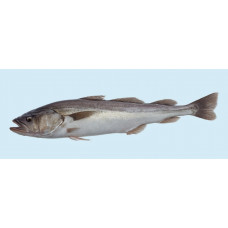Latin name
Arctogadus glacialis
Other name
Polar cod
Identification
Arctic cod are characterized by a thin body, a deeply bifurcated tail, a protruding mouth, large eyes, and teeth on the palate. These fish are distinguished from other cod species by the absence of a chin tendril.
Features of fish fins
Dorsal spines (total): 0; Anal spines: 0.
Fish colouring
The Arctic cod has a simple coloration with a brownish spotted upper body and a silvery lower body. Its fins, which resemble those of the common cod, are almost black with a pale stripe at the base.
Distribution
This species is widespread in the western Arctic Basin and off the northwest and northeast coasts of Greenland. Its range extends from 85°N to 72°N latitude.
Habitat
Deep-sea bathypelagic species. Habitat depths range from 0 to 1000 m, often found under ice.
Size
The maximum length of males of this species is 32.5 cm (12.8 inches).
Behavior
Occurs in ice (cryopelagic or pontic), mostly in coastal waters, on or off the continental shelf. Never migrates.
Food and feeding habits
Arctic cod in the ice-free area off northeast Greenland were found to feed almost exclusively on pelagic prey (mainly paddlefish, amphipods and mysids).
Reproduction
An egg-laying, sexually dimorphic species.
Fishing
This species is of negligible commercial value.
Relationship with a person
Harmless.
| Classification | |
| Phylum | Chordata |
| Class | Actinopterygii |
| Squad | Gadiformes |
| Family | Gadidae |
| Genus | Arctogadus |
| Species | A. glacialis |
| Features | |
| Conservation status | Not Evaluated |
| Habitat | Pelagic |
| Life span, years | No information |
| Maximum body weight, kg | No information |
| Maximum length, cm | 32,5 |
| Sailing speed, m/s | No information |
| Threat to people | Edible |
| Way of eating | Predator |
Arctic cod
Tags: arctic cod


